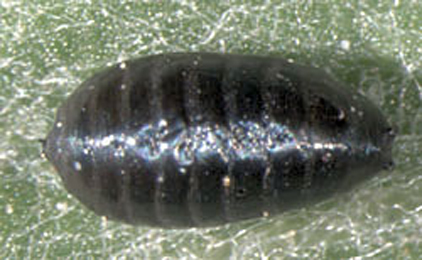|
||||||
|
Phytomyza
artemisivora Spencer, 1971 Phytomyza
artemisivora Spencer, 1971a. Entomologist's Gaz. 22:
179 |
|||||||||||||||||||||||||||||||||||||||||||||||||||||||||||||||||||||||||||||||||||||
|
Leaf-miner: Mine long, whitish, frequently adjoining a vein with frass in separate grains (Spencer, 1976: 387, fig. 675). Little widening upper-surface corridor, up to 8 cm long; sometimes the first part lower-surface. Often the corridor follows a vein or the leaf margin for some distance. The sides are initially quite smooth, later they may be more irregular. Primary feeding lines often visible. Frass in pearl chains and isolated grains, in two neat rows - closely resembling the frass pattern of Liriomyza's. The whitish larva leaves the mine before pupation; exit slit in upper epidermis (Bladmineerders van Europa). The mine is a long corridor, which often partly follows the veins of the leaf, or leaf margin. The frass is in separate grains, with the appearance of stings of pearls (British leafminers). Larva: The larvae of flies are leg-less maggots without a head capsule (see examples). They never have thoracic or abdominal legs. They do not have chewing mouthparts, although they do have a characteristic cephalo-pharyngeal skeleton (see examples), usually visible internally through the body wall. The whitish larva is described by Sasakawa (1961, as albiceps) and illustrated in Bladmineerders van Europa. The larva is without a frontal projection above the mouthparts (Spencer, 1976: 376 (fig. 676)). Puparium: The puparia of flies are formed within the hardened last larval skin or puparium and as a result sheaths enclosing head appendages, wings and legs are not visible externally (see examples). The puparium is illustrated in Bladmineerders van Europa. Shining black; posterior spiracles each with 18-20 bulbs (Spencer, 1976: 387).
Hosts in Great Britain and Ireland:
Hosts elsewhere:
Time of year - mines: August-November. Time of year - adults: August-November. Distribution in Great Britain and Ireland: Derby (Miller's Dale) (Spencer, 1972b: 79), Midlothian (Bawsinch), Fife (Pettycur and West Wemyss) (Bland, 1994c: 82), Warwickshire (Coventry) (Robbins, 1991: 118); Cambridgeshire, Glamorgan, Leicestershire, Shropshire, South Lancashire and South-west Yorkshire (NBN Atlas). Also recorded on Mugwort (Artemisia vulgaris), 11 June. 1985 at Trelee, Co. Kerry, Ireland (H.C.J. Godfray). Distribution elsewhere: Common and Widespread in continental Europe including Denmark, Finland, Norway, Sweden (Spencer, 1976: 386), The Netherlands (Bladmineerders van Europa), Germany (Spencer, 1976: 566), Belgium, Bulgaria, Czech Republic, French mainland, Italian mainland, Poland, Romania, Switzerland and Yugoslavia (Fauna Europaea). Range extending eastwards to the Kirghiz Republic of the [former] U.S.S.R. (Spencer, 1976: 386). NBN Atlas links to known host species:
British and Irish Parasitoids in Britain and elsewhere:
|
| Last updated 10-Jul-2019 Brian Pitkin | ||

